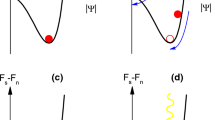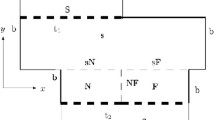Abstract
The mixed state of two-band II-superconductor is analyzed by the multi-symplectic method. As to the Ginzburg-Landau equation depending on time that describes the mixed state of two-band II-superconductor, the multi-symplectic formulations with several conservation laws: a multi-symplectic conservation law, an energy conservation law, as well as a momentum conservation law, are presented firstly; then an eighteen points scheme is constructed to simulate the multi-symplectic partial differential equations (PDEs) that are derived from the Ginzburg-Landau equation; finally, based on the simulation results, the volt-ampere characteristic curves are obtained, as well as the relationships between the temperature and resistivity of a suppositional two-band II-superconductor model under different magnetic intensities. From the results of the numerical experiments, it is concluded that the notable property of the mixed state of the two-band II-superconductor is that: The transformation temperature decreases and the resistivity π increases rapidly with the increase of the magnetic intensity B. In addition, the simulation results show that the multi-symplectic method has two remarkable advantages: high accuracy and excellent long-time numerical behavior.
Similar content being viewed by others
References
Ginzburg V L, Landau L D. On the theory of superconductivity. Zh Eksp Teor Fiz, 1950, 20: 1064–1082
Caroli C, Maki K. Fluctuations of the order parameter in type-II superconductors (I): Dirty limit. Phys Rev, 1967, 159(2): 306–315
Caroli C, Maki K. Fluctuations of the order parameter in type-II superconductors (II): Pure limit. Phys Rev, 1967, 159(2): 316–326
Caroli C, Maki K. Helicon modes in pure type-II superconductors in the high-field region. Phys Rev Lett, 1967, 18(17): 698–700
Caroli C, Maki K. Motion of the vortex structure in type-II superconductors in high magnetic field. Phys Rev, 1967, 164(2): 591–607
Tang Q, Wang S. Time dependent Ginzburg-Landau equations of superconductivity. Physica D, 1995, 88(1): 139–166
Unai A. A remark on time-dependent Ginzburg-Landau equations. SUT J Math, 1997, 33(1): 115–119
Unai A. Global C1-solutions of time-dependent complex Ginzburg-Landau equations. Nonlinear Anal, 2001, 46(3): 329–334
Zhu J X, Kim W, Ting C S. Time-dependent Ginzburg-Landau equations for mixed d-and s-wave superconductors. Phys Rev B, 1998, 58(22): 15020–15034
Chang P H, Liang C T, Chen N C, et al. Superconductivity and mixed-state characteristic of InN films by metal-organic vapor phase epitaxy. Diam Relat Mat, 2006, 15(4–8): 1179–1183
Požek M, Grbić M S, Janjuśević D, et al. Mixed state conductivity of thin niobium films in perpendicular magnetic fields. Physica C, 2007, 460–462: 1291–1292
Tang Y B. Numerical simulations of periodic travelling waves to a generalized Ginzburg-Landau equation. Appl Math Comput, 2005, 165(1): 155–161
Kato M, Sato O. Numerical solution of Ginzburg-Landau equation for superconducting networks. Physica C: Superconductivity, 2003, 392–396(1): 396–400
Nakane K. Numerical calculation of singularities for Ginzburg-Landau functionals with a variable coefficient. Nonlinear Anal, 2001, 47(6): 3803–3811
Fujita A. Numerical study for vortex lattice transition with extended Ginzburg-Landau model. Physica C: Superconductivity, 1998, 309(1–2): 65–70
Bridges T J, Reich S. Multi-symplectic Integrators: numerical schemes for Hamiltonian PDEs that conserve symplecticity. Phys Lett A, 2001, 284: 184–193
Moore B E, Reich S. Multi-symplectic integration methods for Hamiltonian PDEs. Futur Gener Comp Syst, 2003, 19: 395–402
Bridges T J. Multi-symplectic structures and wave propagation. Math Proc Camb Philos Soc, 1997, 121(1): 147–190
Reich S. Multi-symplectic Runge-Kutta collocation methods for Hamiltonian wave equations. Comput Phys, 2000, 157: 473–499
Chen J B. Symplectic and multi-symplectic methods for the nonlinear Schr.dinger equation. Comp Math Appl, 2002, 43: 1095–1106
Kong L H, Liu R X, Xu Z L. Numerical simulation of interaction between Schrödinger field and Klein-Gordon field by multisymplectic method. Appl Math Comp, 2006, 181: 342–350
Chen J B. New schemes for the nonlinear Schrödinger equation. Appl Math Comp, 2001, 124: 371–379
Benettin G, Giorgilli A. On the Hamiltonian interpolation of near to the identity symplectic mappings with application to symplectic integration algorithms. J Stat Phys, 1994, 74: 1117–1143
Frank J, Moore B E, Reich S. Linear PDEs and numerical methods that preserve a multi-symplectic conservation law. SIAM J Sci Comp, 2006, 28: 260–277
Fuchs G, Müller K-H, Handstein A, et al. Upper critical field and irreversibility line in superconducting MgB2. Solid State Commun, 2001, 118(10): 497–501
Hirsch J E. Hole superconductivity in MgB2: A high Tc cuprate without Cu. Phys Lett A, 2001, 282(6): 392–398
Canfield P C, Finnemore D K, Bud’ko S L, et al. Superconductivity in dense MgB2 wires. Phys Rev Lett, 2001, 86: 2423–2426
Finnemore D K, Ostenson J E, Bud’ko S L, et al. Thermodynamic and transport properties of superconducting Mg10B2. Phys Rev Lett, 2001, 86: 2420–2422
Decker W R, Peterson D T, Finnemore D K. Meissner effect for superconductors with magnetic impurities. Phys Rev Lett, 1967, 18: 899–910
Finnemore D K, Hopkins D C, Palmer P E. Coexistence of antiferromagnetism and superconductivity. Phys Rev Lett, 1965, 15: 891–893
Author information
Authors and Affiliations
Corresponding author
Additional information
Supported by the National Natural Science Foundation of China (Grant Nos. 10572119, 10772147 and 10632030), the Doctoral Program Foundation of Education Ministry of China (Grant No. 20070699028), the Natural Science Foundation of Shaanxi Province of China (Grant No. 2006A07), and the Open Foundation of State Key Laboratory of Structural Analysis of Industrial Equipment
Rights and permissions
About this article
Cite this article
Hu, W., Deng, Z. Multi-symplectic method to analyze the mixed state of II-superconductors. Sci. China Ser. G-Phys. Mech. Astron. 51, 1835–1844 (2008). https://doi.org/10.1007/s11433-008-0192-5
Received:
Accepted:
Published:
Issue Date:
DOI: https://doi.org/10.1007/s11433-008-0192-5




